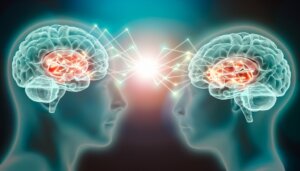Is it Possible to Read Others'Minds?


Written and verified by the psychologist Valeria Sabater
It’s often suggested that psychologists can read minds. Indeed, as a rule, they’re attributed with a form of unusual power that, according to many, makes them understand hidden realities of the human being. However, scientists claim that we all have the wonderful quality of being able to read other people’s emotions and thoughts.
We can’t exactly ‘guess’ what the person in front of us is thinking. Our evolution hasn’t yet reached that point. What we can do is create mental models to effectively intuit feelings, thoughts, and behaviors in others. It’s a learning that we start at a really young age.
We call this competence empathic accuracy. It’s the ability that makes it easier for us to connect with each other in an enriching and skillful way. Thus, we can safely say that most of us are mind readers, with the exception of those on the autism spectrum. Let’s take a closer look.
We can all develop better mind-reading skills. It’s enough to know how to analyze aspects such as non-verbal language.

Mind reading: what processes facilitate this ability?
We spoke at the beginning about how psychologists are often seen as mind readers. In reality, if they’re at all skillful in this matter, it’s due to the fact that their work is based, in large part, on observing and actively listening to others.
This activity allows them to transcend beyond gestures and words to intuit emotions, needs, traumas, and thoughts. Furthermore, psychologists are trained to read aspects related to non-verbal communication. Nevertheless, this is something that, in reality, the vast majority of us can also do with greater or lesser success.
People give clues to what’s in their minds through gestures, movements, looks, and tone of voice. In fact, mind reading isn’t a superpower, it’s an ability that comes from empathy and the reading of body language.
However, you can’t become a reader of other people’s emotions and thoughts if you haven’t delved into your own mind first. So, let’s take a look at those processes that make it easier for you to acquire this ability.
Theory of mind: the ability to “think that I think that you think…”
The theory of mind was coined by the anthropologist and psychologist, Gregory Bateson. It defines the ability that people have to understand and reflect on their own mental state and also that of others. A study conducted by the University of Wisconsin-Madison (USA) claimed that the ability to reason about the thoughts, beliefs, and feelings of others and to be able to predict their responses and actions promotes our well-being. For example, say your partner arrives home stressed and angry, hence you deduce that they may have had a bad day at work.
On the other hand, research conducted by Veddum, Pedersen, Landert, and Bliksted claimed that people with autism spectrum disorder and patients with schizophrenia show a deficit in the development of the theory of mind.
Mirror neurons, the everyday keys to mind reading
Vittorio Gallese, a neuroscientist at the University of Parma in Italy and one of the original discoverers of mirror neurons, claimed that we’re all natural mind readers. Everyone except, according to him, Spock, one of the protagonists of Star Trek. In his case, his difficulty in understanding human behavior lay precisely in the emotional aspect.
The inhabitants of Vulcan had chosen to suppress their emotions in order to act more logically. This deprived them of being able to acquire the faculty that’s so exceptional in the human being: empathy. Indeed, our empathic abilities, governed by mirror neurons, make it easier for us to enter the minds of others and connect with their emotional states.
Therefore, when you interact with someone, you do more than just look. You connect with that person emotionally and mentally, you get into their shoes, and enter the refuge of their mental universe.
People with autism do have empathy. However, they tend to have more difficulty picking up and understanding the emotional cues that others show. This can cause them to respond in an impulsive and maladjusted way.

Non-verbal language can provide more information than words
You don’t have to be a Jedi to read minds. It’s not even necessary to concentrate and gaze deeply into the eyes of the person in front of you. In fact, you must go further and broaden your focus to look at their body, voice, and movements.
David Matsumoto, a professor at San Francisco State University, is one of the leading experts on this subject. In his book, Nonverbal Communication. Science and Applications, he offers us information on how to delve into non-verbal behaviors to understand people’s thoughts, motivations, personalities, and intentions.
As an adviser to the FBI, he affirms that reading the mind of the human being is possible as long as we have adequate knowledge on the subject. In fact, his work is based on training federal agents and businessmen in the ability to read people to intuit behaviors and reactions.
Therefore, it’s clear that most of us are proficient in this fascinating skill. The most interesting thing, without a doubt, is knowing that we can learn much more and that there are resources and experts who can guide us in this type of interpersonal reading. Although it may seem rather striking to us, it’s simply a tool that facilitates and optimizes our relationships.
It’s often suggested that psychologists can read minds. Indeed, as a rule, they’re attributed with a form of unusual power that, according to many, makes them understand hidden realities of the human being. However, scientists claim that we all have the wonderful quality of being able to read other people’s emotions and thoughts.
We can’t exactly ‘guess’ what the person in front of us is thinking. Our evolution hasn’t yet reached that point. What we can do is create mental models to effectively intuit feelings, thoughts, and behaviors in others. It’s a learning that we start at a really young age.
We call this competence empathic accuracy. It’s the ability that makes it easier for us to connect with each other in an enriching and skillful way. Thus, we can safely say that most of us are mind readers, with the exception of those on the autism spectrum. Let’s take a closer look.
We can all develop better mind-reading skills. It’s enough to know how to analyze aspects such as non-verbal language.

Mind reading: what processes facilitate this ability?
We spoke at the beginning about how psychologists are often seen as mind readers. In reality, if they’re at all skillful in this matter, it’s due to the fact that their work is based, in large part, on observing and actively listening to others.
This activity allows them to transcend beyond gestures and words to intuit emotions, needs, traumas, and thoughts. Furthermore, psychologists are trained to read aspects related to non-verbal communication. Nevertheless, this is something that, in reality, the vast majority of us can also do with greater or lesser success.
People give clues to what’s in their minds through gestures, movements, looks, and tone of voice. In fact, mind reading isn’t a superpower, it’s an ability that comes from empathy and the reading of body language.
However, you can’t become a reader of other people’s emotions and thoughts if you haven’t delved into your own mind first. So, let’s take a look at those processes that make it easier for you to acquire this ability.
Theory of mind: the ability to “think that I think that you think…”
The theory of mind was coined by the anthropologist and psychologist, Gregory Bateson. It defines the ability that people have to understand and reflect on their own mental state and also that of others. A study conducted by the University of Wisconsin-Madison (USA) claimed that the ability to reason about the thoughts, beliefs, and feelings of others and to be able to predict their responses and actions promotes our well-being. For example, say your partner arrives home stressed and angry, hence you deduce that they may have had a bad day at work.
On the other hand, research conducted by Veddum, Pedersen, Landert, and Bliksted claimed that people with autism spectrum disorder and patients with schizophrenia show a deficit in the development of the theory of mind.
Mirror neurons, the everyday keys to mind reading
Vittorio Gallese, a neuroscientist at the University of Parma in Italy and one of the original discoverers of mirror neurons, claimed that we’re all natural mind readers. Everyone except, according to him, Spock, one of the protagonists of Star Trek. In his case, his difficulty in understanding human behavior lay precisely in the emotional aspect.
The inhabitants of Vulcan had chosen to suppress their emotions in order to act more logically. This deprived them of being able to acquire the faculty that’s so exceptional in the human being: empathy. Indeed, our empathic abilities, governed by mirror neurons, make it easier for us to enter the minds of others and connect with their emotional states.
Therefore, when you interact with someone, you do more than just look. You connect with that person emotionally and mentally, you get into their shoes, and enter the refuge of their mental universe.
People with autism do have empathy. However, they tend to have more difficulty picking up and understanding the emotional cues that others show. This can cause them to respond in an impulsive and maladjusted way.

Non-verbal language can provide more information than words
You don’t have to be a Jedi to read minds. It’s not even necessary to concentrate and gaze deeply into the eyes of the person in front of you. In fact, you must go further and broaden your focus to look at their body, voice, and movements.
David Matsumoto, a professor at San Francisco State University, is one of the leading experts on this subject. In his book, Nonverbal Communication. Science and Applications, he offers us information on how to delve into non-verbal behaviors to understand people’s thoughts, motivations, personalities, and intentions.
As an adviser to the FBI, he affirms that reading the mind of the human being is possible as long as we have adequate knowledge on the subject. In fact, his work is based on training federal agents and businessmen in the ability to read people to intuit behaviors and reactions.
Therefore, it’s clear that most of us are proficient in this fascinating skill. The most interesting thing, without a doubt, is knowing that we can learn much more and that there are resources and experts who can guide us in this type of interpersonal reading. Although it may seem rather striking to us, it’s simply a tool that facilitates and optimizes our relationships.
All cited sources were thoroughly reviewed by our team to ensure their quality, reliability, currency, and validity. The bibliography of this article was considered reliable and of academic or scientific accuracy.
- Byom LJ, Mutlu B. Theory of mind: mechanisms, methods, and new directions. Front Hum Neurosci. 2013 Aug 8;7:413. doi: 10.3389/fnhum.2013.00413. PMID: 23964218; PMCID: PMC3737477.
- Bambaeeroo F, Shokrpour N. The impact of the teachers’ non-verbal communication on success in teaching. J Adv Med Educ Prof. 2017 Apr;5(2):51-59. PMID: 28367460; PMCID: PMC5346168.
- Riess H. The Science of Empathy. J Patient Exp. 2017 Jun;4(2):74-77. doi: 10.1177/2374373517699267. Epub 2017 May 9. PMID: 28725865; PMCID: PMC5513638.
- Shamay-Tsoory, Simone G.; Aharon-Peretz, Judith (2007-01-01). «Dissociable prefrontal networks for cognitive and affective theory of mind: A lesion study». Neuropsychologia 45 (13): 3054-3067
This text is provided for informational purposes only and does not replace consultation with a professional. If in doubt, consult your specialist.







